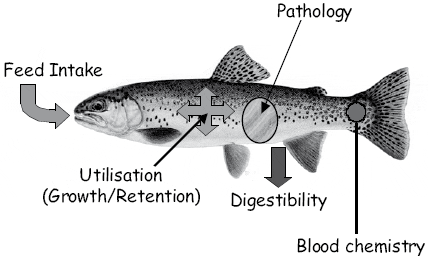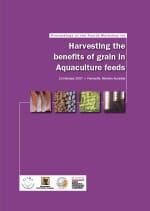Introduction
Modern aquaculture diets are complex assemblages of a range of raw materials (formulation) processed to make a feed that satisfies the demands of the animal for nutrients and energy (specifications). In most modern fish diets, the specifications are now often prescribed on a digestible nutrient and energy basis. In the formulation process not only are the diet specifications a critical aspect to the diet, but also the cost of the formulation, its process-ability (ability to make it into a pellet) and also the consideration of the potential for certain raw materials to introduce deleterious biologically active compounds, are all important issues.
The assessment of different feed grain options for use in fish diets can be undertaken using several different strategies. While there is seldom one perfect strategy to provide all answers, there are certain methods that can provide more useful data than others for the formulation of cost-effective, viable fish diets (Glencross et al., 2007). Generally knowledge on raw materials in feeds for fish is gained by producing feeds with the raw material in question being varied, and the feed then being fed to fish in a variety of treatments. The strategy used for diet design is also open to several strategies. A range of assessments to this feeding process can then be applied. Generally there are five loci where the effect of a feed on fish can be routinely assessed, and by inference the effect of a raw material, depending on the feed formulation and specifications (Figure 1). These five loci can be considered as: (1) feed intake, (2) utilisation, (3) pathology, (4) blood chemistry, and (5) digestibility. Of these five the assessment of digestibility, palatability and utilisation are the primary loci of importance in the assessment of raw material effects. If there are subsequent aberrations determined in these loci, then further assessment of the others is sometimes used to determine specifically what is going on.
 |
| Figure 1. Key loci for studying the interaction of a feed with fish. |
Methods of Assessment
Digestibility of diets, and by inference certain component raw materials, are one of the more practical assessment methods used in aquaculture nutrition research. There are a range of methods that can be used to determine the digestibility of raw materials and key considerations include the diet design and faecal collection method used (Glencross et al., 2007). There has been considerable debate over the more relevant method to use in the collection of faeces for the assessment of digestibility in fish (Vandenberg and de la Noue, 2001). However, the use of faecal stripping techniques is accepted as a more conservative technique in digestibility assessment and because of this has gained more widespread acceptance as a faecal collection technique for commercially used data (Glencross et al., 2005).
Provided a diet is formulated on a digestible nutrient and energy basis, and it satisfies the animal’s nutrient and energy requirements, most variability in performance is then usually attributable to vagaries in feed intake. Therefore, armed with knowledge on digestibility and palatability of a raw material, its potential value becomes substantially clearer. To determine the palatability of a raw material the effect that it has on feed intake needs to be assessed. Again this is dependent on diet design, but generally involves the addition of the raw material in question, in increasing levels, to a reference diet (Glencross et al. 2006). The diets are then fed to tanks of fish and the feed intake determined based on the amount fed minus the collected uneaten feed (Helland et al., 1996). The feed intake variability is well known to be most sensitive within the first week of introduction of a feed to fish and therefore this period, prior to adaptation, can be used to better discriminate palatability effects (Wybourne and Carter, 1999). The final assessment of feed intake effects can be examined either on a pair-wise time-series basis or simply as a comparison of differences in absolute intake over a period of time (Glencross et al., 2006).
Utilisation can be measured in several ways (Glencross et al., 2007). One of the most obvious ways is to assess the weight gain achieved when fish are fed certain diets. In this regard, fish are fed a particular diet for a certain period of time and their weight gain measured between two time points after being fed on a diet. Comparisons can then be made among treatments and inferences made according to what the diets where. Further detail can be added to this style of assessment by examining the changes in composition of the animal, for example protein and/or energy (or indeed any nutrient) as a function of the intake of protein or energy (Cho and Kaushik, 1990; Lupatsch et al., 2003). This is referred to as the protein or energy retention efficiency. Assessment of fatty acid demands and utilisation of alternative oils resources in particular requires considerable focus on the utilisation aspects of the diets (Glencross et al., 2003). There are many variants that can be applied on the general principles of utilisation studies and all have some value depending on the questions being asked. The different strategies have been reviewed in Glencross et al. (2007).
In some instances the assessment of digestibility, palatability and utilisation will identify problems. In some instances further assessment strategies are required to determine why such problems are occurring. Pathology assessment using histology is one option. By examining the changes in cellular structure of certain organs from fish from certain treatment, relative to those from control treatments the effects of raw materials on certain pathologies can be determined. For instance the assessment of soybean meal inclusion on the cellular structure of the distal intestine of Atlantic salmon has been shown to cause a condition referred to as ‘distal enteritis’ (Refstie et al. 2006). A histological assessment can also be used to provide some assurance that no organ damage is occurring with the inclusion of certain raw materials, and a focus on gut, liver and kidney tissues can provide some assurance of whether-or-not any damage at a cellular level is occurring (Glencross et al., 2006a).
The assessment of blood chemistry can provide a further avenue for understanding the effects of raw materials. Parameters such as hormones, glucose, amino acids among others can all be evaluated. In some cases the observations need to be regarded according to species and feed intake to ensure the correct interpretation is arrived at.
Irrespective of the assessment method used, the appropriate diet design is central to the effective assessment of raw material implications in fish diets. However, the strategic assessment of digestibility, palatability and utilisation features of any raw material can provide a sound basis for determining its potential in an aquaculture feed.
Extrusion Processing
Because raw materials have to be combined to satisfy both nutritional and physical constraints of feeds it is important that the effect that raw materials have on feed processing are also considered (Kaushik, 2001). Most modern aquaculture feeds for fish are produced using an extrusion process (Hardy and Barrows, 2002). Because of this it is pertinent that the raw materials being studied are also assessed using similar technology.
A range a strategies can be used to assess the effect of raw materials on extrusion, but the simplest involves the addition of the raw material being considered to a reference diet and it being processed using fixed operating conditions. Other alternatives include adding the raw material, but maintaining a fixed composition, or even varying the operating conditions to determine the optimal processing parameters required to work with certain raw materials (Evans, 1999).
Whatever the strategy used to process the diet, the pellets produced still require some form of assessment of their physical properties to allow the effect of the raw material to be determined.
References
Cho, C.Y. and Kaushik, S.J., 1990. Nutritional energetics in fish: Energy and protein utilisation in rainbow trout (Salmo gairdneri). World Rev. Nutr. Dietetics 61;132-172.
Evans, T.J. 1999. Replacement of Fish Meal in Aquaculture diets – Feed Processing Project 93/120-06. Fisheries Research & Development Corporation.
Glencross, B.D., Hawkins, W.E. and Curnow, J.G., 2003. Restoration of the fatty acid composition of red seabream (Pagrus auratus) after grow-out on plant oil based diets. Aquaculture Nutrition 9;409-418.
Glencross, B.D., Hawkins, W.E., Evans, D., McCafferty, P., Dods, K., Maas, R. and Sipsas, S. 2005. Evaluation of the digestible value of lupin and soybean protein concentrates and isolates when fed to rainbow trout, Oncorhynchus mykiss, using either stripping or settlement faecal collection methods. Aquaculture 245;211-220.
Glencross, B.D., Hawkins, W.E., Evans, D., McCafferty, P., Dods, K., Jones, J.B., Sweetingham, M., Morton, L., Harris, D. and Sipsas, S. 2006. Evaluation of the influence of the lupin alkaloid, gramine when fed to rainbow trout (Oncorhynchus mykiss). Aquaculture 253;512-522.
Glencross, B.D., Booth, M. and Allan, G.L. 2007. A feed is only as good as its ingredients – A review of ingredient evaluation for aquaculture feeds. Aquaculture Nutrition 13;17 – 34.
Hardy, R. W. and Barrows, F.T. 2002. Diet formulation and manufacture. In: Fish Nutrition (J.E. Halver and R.W. Hardy Eds.). Academic Press, San Diego, USA. pp 506-601.
Helland, S., Grisdale-Helland, B. and Nerland, S., 1996. A simple method for the measurement of daily feed intake of groups of fish in tanks. Aquaculture 139;156-163.
Kaushik. S.J. 2001. Feed technologies and nutrient availability in aquatic feeds. In: Advances in Nutritional Technology 2001 (A.F.B. van der Poel, J.L. Vahl, R.P. Kwakkel Eds.) Wageningen Pers, Wageningen, Netherlands. pp 187-196.
Lupatsch, I., Kissil, G.Wm. and Sklan, D., 2003. Comparison of energy and protein efficiency among three fish species Sparus aurata, Dicentrarchus labrax and Epinephelus aeneus: energy expenditure for protein and lipid deposition. Aquaculture 225;175-189.
Vandenberg, G.W. and de la Noue, J., 2001. Apparent digestibility comparison in rainbow trout (Oncorhynchus mykiss) assessed using three methods of faeces collection and three digestibility markers. Aquaculture Nutrition 7;237-245.
Wybourne, B.A. and Carter, C.G., 1999. The effect of plant meal inclusion on feed intake and nutritional adaptation by Atlantic salmon, Salmo salar L. In: Fishmeal replacement in Aquaculture Feeds for Atlantic salmon. Project 93/120. Fisheries Research and Development Corporation, Canberra, Australia. pp 100-126.
Further Reading
|
|
- You can view the booklet; 'Harvesting the benefits of grain in Aquaculture feeds' by clicking here. |
November 2007


